LAND OF HAPPINESS: BHUTAN
Description
Take a cultural journey through the entire width of Bhutan from west to east. Savour the local flavour of each region moving back in times till we reach the outermost outpost of Bhutan. We start our journey from Paro, probably one of the biggest and most fertile valleys. Besides visiting the museum and Dzong we hike up to Takstang monastery built on a sheer rock face. We then travel to the capital city of Thimphu. Though modern, it has tried to save its art, culture and traditions from the influences of the outside world. We drive to Punakha, which has the PunakhaDzong dominating the valley floor. Post which we visit the winter home of the rare and endangered black necked cranes, Gangtey valley and visit the 17th century monastery. While driving towards last destination via Thrumshing, enjoy the spectacular mountain views as you arrive at Samdrup Jongkhar – the last town of Bhutan. The trip concludes in Guwahati.
| DESTINATION | Bhutan |
| ACTIVITY LEVEL | Moderate |
| BEST SEASON | March – May and September – November |
Itinerary
1
Day 1: Arrival: Paro, transfer to Thimphu
On arrival, guests will be received at the airport by Destinaro representative who will be your tour guide and companion for the whole duration of your tour in Bhutan.
Drive to your hotel in Thimphu. After refreshing yourselves and having lunch, visit the following
Kuensel phodrang The Kuensel Phodrang or the Buddha point is the world‟s largest sitting Buddha statue, the statue is 167 feet high. The statue is situated on top of a hill overlooking the city of Timphu, it can be accessed by road and is about 15 minutes away from the city‟s center. The word Kuensel means everything is clear and from this place you will sure enjoy a great view of the Thimphu Valley on both sides. The statute will house a temple inside it, the statue and its adjoining car park and recreational center are currently under construction and is expected to be ready by December 2012. The statue is constructed out of bronze and is studded with many semi-precious stones. Since they are no factories in country that can make such a large bronze cast structure, statute is being manufactured in China and the pieces are brought to Bhutan and are assembled here. On the drive to the statue the steep winding hill road offers an unparalleled view of the city of Thimphu and is an excellent place to capture a view of the city especially after dark. A journalist once described the view as “seeing an osasis of light in the desert of darkness “as the city light of Thimphu shine very bright in an otherwise dark Thimphu valley.
Motithang Takin preserve: The Motithang Takin Preserve also known as the Thimphu Zoo by many is a small natural preserve for the Takin Bhutan‟s national animal. It was originally a mini zoo, but it was converted in a preserve later on as the Takin. The mini zoo contained a small number of Takin but the King of Bhutan later decreed that it was improper for a Buddhist nation to keep an animal in captivity. The animals were set free and the zoo was shut down, but for some reason the Takin refused to leave the area for the forests nearby. Instead the animals were frequesntly found roaming around the streets of the capital city in search for food. As a result the government decided to demarcate an 8 acre fenced location as the Motithang Takin Preserve. The preserve is a forested preserve that mimics the Takin‟s natural habitat, in addition to the Takin there are a few musk deer and barking deer that live inside the preserve. There are plans to expand the preserves collection to include other rarely seen animals that live in Bhutan, currently the preserve plans to add the Red Panda and the Himalayan Serow to the preserve.
Later in the evening you can visit Tashichho Dzong: The Tashichho Dzong is a Buddhist monastery cum fortress at the northern edge of Thimpu the capital city of Bhutan. The Dzong was built on the western bank of the river Wang Chu, and has historically served at the seat of the Druk Desi or the Dharma Raja of Bhutan‟s government. After the kings assumed power in 1907 this post was combined with that of the king and Thimphu severed as the summer caital of the kingdom before becoming the full time capital of Bhutan. The original Thimphu Dzong (the Dho-Ngyen Dzong) is said to have been constructed in 1216 by Lama Gyalwa Lhanangpa. And was later taken over by Lama Phajo Drukgom Shigpo before the Dzong was conquered by Shabdrung Ngawang Namgyal, who found the Dzong to be too small and expanded it to what is now known as theTashichho dzong is also called the “fortress of glorious religion.” It was erected in 1641 and was subsequently rebuilt by King Jigme Dorji Wangchuck in the 1960s. The Dzong has been
seat of the Royal government since 1952 and presently houses the Throne room and the Kings secretariat. The Tashichho dzong is also home to several ministries of the Bhutanese government, and the Central Monk Body which is the apex organization of the country’s main spiritual order. The monument welcomes visitors during the Thimphu Tsechu festival which is held in autumn each year. The Dzongs main structure is a two striped quadrangle with 3 storied towers on each of its four cornersOvernight in Thimphu
2
Day 2: Thimphu sightseeing)
Post breakfast visit the Immigration Office to extend your permit to go towards Punakha. Then, visit the following
Jungshi Handmade Paper Factory: This is a private factory and they manufacture a special watermark paper as well as products such as lampshades, envelopes and other objects made of traditional Bhutanese paper. They make great gifts to take home with you and are genuinely unique. It is not just the texture of these handmade paper products that will intrigue you, but also their unique earth tones and natural hews. This factory manufactures a special watermark paper as well as products such as lampshades, envelopes and other objects made of traditional Bhutanese paper. Bhutan protects its environment through long-term sustainability, and they follow it because they do not destroy the plant when they extract the raw material required. Paper products are manufactured from “daphne papyracea”.
Folk Heritage Museum: The folk heritage museum was open to the general public in 2001 upon completion. It treasures troves of culture and rich Bhutanese heritage provide rich insights into the Bhutanese ethos. Try to schedule your visit during the morning hours since the museum is less crowded at that time and there is plenty of sunlight to go around. The folk heritage museum is housed in a replica traditional Bhutanese house learn first-hand about Bhutan‟s rich cultural traditions, its deeply rooted heritage which spans thousands of years and the Bhutanese way of life. The tour of this almost living museum will also give you a glimpse onto how many rural folk of the country live today following the ancient Bhutanese ways.
Memorial Chorten: Referred to as the Memorial Chorten, it’s actual name is Gongzo Chorten or Gyaldren Chorten. The chorten (stupa) is a chief landmark in the capital city and is also a most sacred place of worship for local people. The idea of the chorten was conceptualized by the Third King His Majesty Jigme Dorji Wangchuck to ward-off negative energies. After His Majesty’s demise, the chorten was built in his memory by the 4th King and the then Queen Mother in 1972. Many old people come here early in the morning to circumambulate and say their prayers in the hopes of garnering enough good karma for their afterlife; they are joined by the middle and the younger generation in the evenings who also come to do either the same thing or to just relax their mind. The doors of this stupa remain mostly closed except on holy days. Inside, there are three stories and on each floor are statues of protective deities.
Changangkha Lhakhang: It is a 12th century temple sitting on top of a hill overlooking Thimphu valley with the main statue of Chenrizig (The Buddha of Compassion). This temple is often mistaken for a dzong by visitors because it looks like one, and apart from the temple it also houses a monastic school. Most of the couples go to this temple soon after birth to get blessings for their child.Overnight at a hotel in Thimphu.
3
Day 3: Thimphu – Punakha
Post breakfast, drive toward Punakha, stop at Dochula Pass (3,100 m), where on a sunny day, you can get stunning views of the Himalayan ranges. The Dochu La Pass is probably the best known mountain pass in Bhutan. Located at an altitude of 3150 meter above sea level, the Dochu La Pass is about 30 kilometer away from the capital city Thimphu and the road to Punakha. On a clear day the pass offers visitors a spectacular view of the majestic eastern Himalayan Ranges. A cup of hot coffee or tea at the pass has almost become part of tradition for people travelling to and fro from Punakha to the capital city.
There is a small cafeteria at the pass that offers a chance for travelers to enjoy a hot beverage or a snack, it is located just off the road and overlooks the pass and is an ideal place to sit back, relax and enjoy the view. Another striking feature at the pass are the 108 Druk Wangyal Khangzang Chortens, that were built for the well-being of all sentiment beings on earth. The 108 Chorten were built as a tribute to the Kings of Bhutan for their selfless service and leadership they offer to the people of Bhutan. These Stupas or Chortens also represent the peoples love, appreciation and loyalty towards the country’s King.
Continue drive towards Punakha and stop at Lobesa village and have lunch before going for a short hike to Chimi Lhakhang (Temple of Fertility), it is dedicated to Lam Drukpa Kuenley (Divine Mad Man) and is the place from where Phalluses originated as the symbol of fertility and protection and can be seen everywhere in Bhutan, on house walls and roofs and altars. Childless couples usually go to this temple to get blessings so that they conceive and are blessed with a child.
(NOTE: The temple and has some sexual depictions. You may want to reconsider visiting this place if you are not comfortable with children seeing these)
Then drive to Punakha Dzong: The Punakha Dzong or the Pungtang Dechen Phortang Dzong is located at the confluence of the Mo Chhu and the Po Chhu River, combine to form the Puna Tsang Chu which in turn is a tributary of the mighty Brahmaputra River. The Dzong was constructed by Zhabdrung Ngawang Namgyal in 1638 on the exact spot as prophesized by the Guru Rinpoche some 800 years ago. According to the prophecy of Guru Rinpoche “a person named Namgyal will arrive at a hill that looks like an elephant”. Another legend associated with the Dzong is that of Zowe Palep, the architect of the Dzong received vision of the Dzong in his sleep. This vision got imprinted in the architects mind and enabled him to construct the Dzong without putting his plans to paper.
It is the second largest and the second oldest Dzong in Bhutan. The Dzong is home to some of the most sacred relics of the Drukpa Kagyu School of Buddhism; it is also home to the sacred mortal remains of Zhabdrung Ngawang Namgyal and Terton Pema Lingpa the great treasure discoverer of Bhutan. The Dzong has also served as the capital Bhutan till 1955 before the capital was moved to Thimphu. The Dzong is still the winter residence of the Je Khenpo (chief abbot) and the central monastic body and plays host to the annual Punakha Tshechu Festival which is very popular with the locals and tourists alike.Overnight at a hotel in Punakha.
4
Day 4: Punakha sightseeing
Post breakfast, drive north to KHAMSUM YUELLEY NAMGYAL CHORTEN: Khamsum Yuelley Namgyel Chorten, a temple that stands majestically on a strategic ridge above Punakha valley. The temple was built by the Queen Mothers to ward off negative energies, promote peace, stability and harmony in a changing world after it was prophesied in the scriptures by Thragthung Dudjom Lingpa.. It is said all its unique architectural designs have been drawn from the scriptures. The hike takes about 45 minutes one way through relatively easy path through paddy fields and thin pine forest. Once at the top, you can enter
the stupa and climb all the way to the top for a breath taking view of the valley belowHave lunch in town and then visit the following
Sangchen Dorji Lhuendrup Nunnery: Perched on a ridge amid pine trees and overlooking valleys of Punakha and Wangdue Phodrang is the magnificent stupa like temple built by the 5th King’s Maternal Grandfather to encourage females to pursue Buddhist studies. The temple houses a 14 foot main bronze statue of Avalokiteshvara. Other statues include those of Guru Padmasambhava, Gautama Buddha, Zhabdrung Ngawang Namgyal, Tshela Namsum, the 21 Taras and Tshepamey (Buddha of Longevity). The Avalokiteshvara statue, one of the biggest in the country, is the handiwork of entirely local Bhutanese artisans. The temple complex also houses a permanent higher learning and meditation center for nuns, where, apart from religious trainings, also provides life skills trainings such as tailoring, embroidery, statue sculpting and thanks (scroll) painting. Overnight at a hotel in Punakha.
5
Day 5: Punakha – Phobjikha valley
Post breakfast drive to Phobjikha, the valley of the Black Necked Cranes. This is believed to be a glacial valley and is the winter nesting grounds for the endangered Black Necked Cranes, they start arriving by October end and leave for the Tibetan plateau by February. Visit the beautiful 17th Century Gangtey Monastery, it is the largest privately funded Nyingma Monastery in the country and was recently renovated in 2007, some surrounding beautification works are still being done.
Then go for the Nature Trail hike that takes you around the valley from where you can get spectacular views of the valley below. Your car will pick you up down in the valley and take you for lunch.Post lunch, you can walk around the valley and enjoy the serenity.Overnight at a hotel in Phobjikha.
(NOTE: Road between Punakha and Phobjikha is under renovation process and rough drive is to be expected)
6
Day 6: Punakha – Paro
After breakfast, trace the road back up to Dochula and then to Thimphu where you can have lunch.
Post lunch drive to Paro, on the way visit Tamchog Lhakhang: Tachog lhakhang is temple that is dedicated to the 13th century saint Thangthong Gyalpo, the iron bridge builder. This temple is located across the river about 15kms from the Paro towards Thimphu. In order to get to the temple one must cross an iron chain bridge, one of the few remaining of the many that Thangthong Gyalpo built. This is a private temple however tourists are allowed to visit if they are given permission. Crossing this very old bridge with its swaying and undulating movements can be quite an experience. The temple’s location on the ridge and the high rocky barren hills which serve as its backdrop makes this a good location to take pictures.
Kyichu Lhakhang: Considered the oldest temple along with Jampa and Kenchosum Lhakhang in Bumthang, it dates back to the 7th century when a Tibetan King ordered 108 temples to be built in a single night to subdue a huge ogress. It was later renovated in the mid 19th century and in the late 1960’s by the Grand Queen Mother. It is also considered by many to be one of the holiest places in the country. Inside the compound is an orange tree which always has oranges no matter what the season.
Ta Dzong (National Museum): The name Ta Dzong translates to ‘watch tower’ and it served the function of watch tower for the Paro Rinpung Dzong. Back in the day, similar look-out points were built for other dzongs (fortresses) to counter any approaching hostilities, for those were the days of frequent strife. These towers were specifically built high atop hills and other vantage points during the old days. Presently serving as the national museum (since late 60’s), it houses an array of antiquities such as ancient thangka (exquisite scroll painting), mural paintings and other forms of art done by great personalities of those days, original textiles of the kingdom which represent the culture that still flourishes, weapons &
armour used back in the day, household objects typical to the Bhutanese people’s way of life back then and even now, and other natural and historical artifacts.Overnight at a hotel in Paro.
7
Day 7: Paro, Tiger’s Nest hike
Have early breakfast and drive up to the base of Taktsang Monastery (Tiger’s Nest). The most famous and sacred site among all the places in Bhutan. Guru Padmasambhava is said to have come riding on a flying tigress to this place and meditated in a cave for 3 months, it wasn’t until Zhabdrung Ngawang Namgyal came to this place and meditated that it gained the popularity that it has now. The present structure is said to be built in the 15th century but was destroyed by fire in 1998 and has been restored.
The walk is about 2 hours till the top through wide pathways which was built during the restoration works. One hour into the climb there is a tea point from where you get a very good view of the monastery, they also serve lunch here. From there it’s about another 45 minutes climb to the 2nd view point and the highest point in the hike.Overnight at a hotel in Paro
8
Day 8: Depart
Reviews (0)
You must be logged in to post a review.


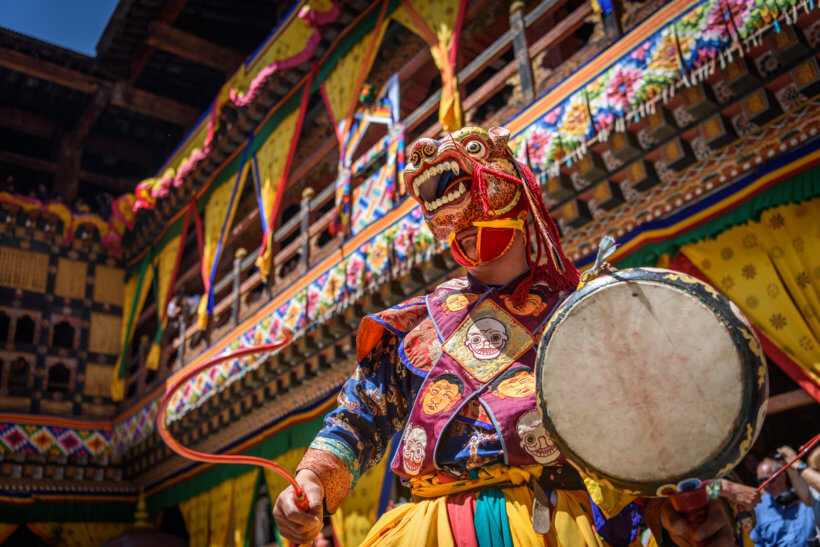
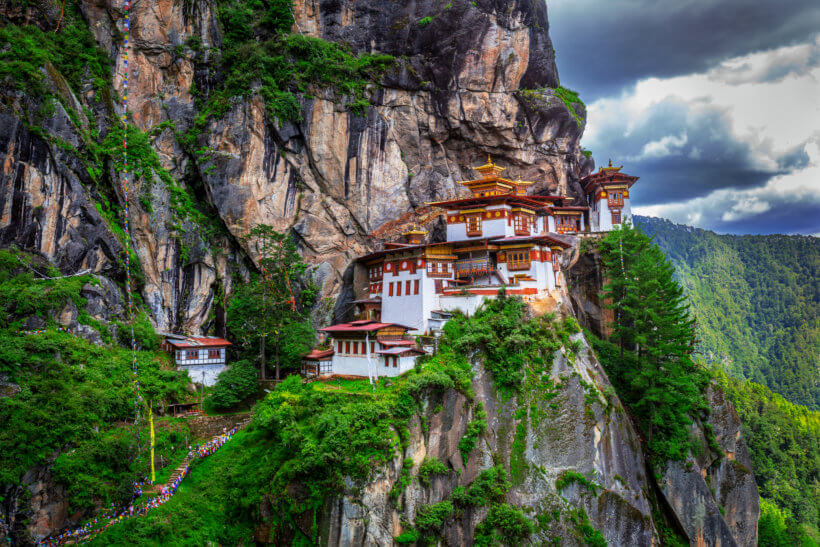
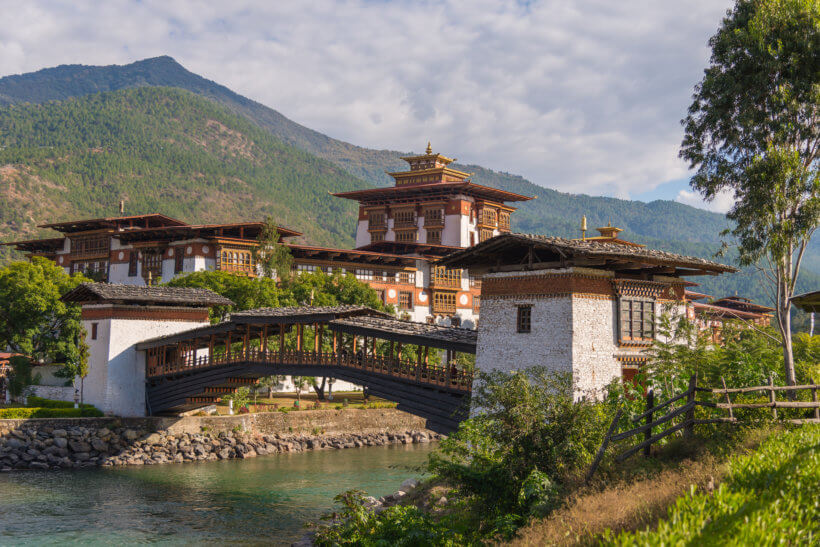
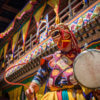
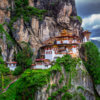
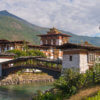
Reviews
There are no reviews yet.